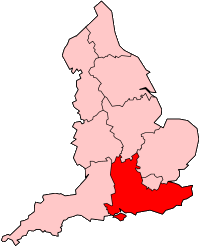Thameslink
Thameslink is a 24-hour, 115-station main-line route in the British railway system, running from Bedford, Luton, St Albans City, Peterborough and Cambridge via central London to Sutton, Orpington, Sevenoaks, Rainham, Horsham and Brighton. Additional services to East Grinstead and Littlehampton operate at peak times. The network opened as a through service in 1988, with severe overcrowding by 1998, carrying more than 28,000 passengers in the morning peak. All the services are currently operated by Govia Thameslink Railway.
Class 700 Desiro City standing at London Blackfriars in 2016 | |||
| Overview | |||
|---|---|---|---|
| Franchise(s) |
| ||
| Main region(s) | London, Bedfordshire, Hertfordshire, Cambridgeshire, Surrey, Kent, Sussex | ||
| Fleet size | 115 Class 700 Desiro City | ||
| Stations called at | 115 | ||
| Parent company | Govia Thameslink Railway | ||
| Reporting mark | TL (Thameslink) | ||
| Technical | |||
| Track gauge | 1,435 mm (4 ft 8 1⁄2 in) standard gauge | ||
| Electrification | 25 kV 50 Hz AC OHLE 750 V DC third rail | ||
| Other | |||
| Website | www | ||
| |||
The Thameslink Programme is a major £5.5 billion scheme to increase capacity on the central London section by accommodating more frequent and longer trains. The upgrade was scheduled for completion in 2019. In 2016, new Class 700 trains started operating on the route and have now replaced the Class 319, Class 377 and Class 387 trains which were withdrawn and transferred elsewhere.
Route
Much of the original route is over the Brighton Main Line (via London Bridge) and the southern part of the Midland Main Line, with a suburban loop through Sutton and Wimbledon. A branch via the Catford Loop Line to Sevenoaks was added in 2012. Sections to Peterborough on the East Coast Main Line, Cambridge via the Cambridge Line, Horsham on the Arun Valley line and Rainham via Greenwich were added in 2018. East Grinstead and Littlehampton are also served in peak hours.
The route through central London is via St Pancras International for connections to Eurostar and the East Midlands; Farringdon, for London Underground Circle, Metropolitan and Hammersmith & City lines, and soon Crossrail; City Thameslink, which replaced the demolished Holborn Viaduct station and has a southern entrance serving Ludgate Circus; Blackfriars, for main-line rail services and the Underground District and Circle lines; and London Bridge for main-line links into Kent and Sussex and the Underground Northern and Jubilee lines. King's Cross Thameslink on Pentonville Road closed on 8 December 2007.
Trains operating the "main line" service (Bedford to Brighton, Peterborough to Horsham) include first-class accommodation; those operating from Luton, St Albans and Kentish Town to Sutton, Sevenoaks and Orpington are usually standard class only.[1] When Govia operated the original Thameslink franchise these services were designated "Thameslink CityFlier" and "Thameslink CityMetro" respectively, but First Capital Connect dropped this branding. Govia Thameslink Railway now refers to these services as Route TL1 (formerly Route 6) and Route TL2/TL3 (formerly Route 7/8) respectively.
Services
Thameslink service pattern
The published Thameslink off-peak service pattern as of May 2020, with frequencies in trains per hour (tph), includes:
| Regional routes | |||
|---|---|---|---|
| Route | tph | Calling at | Stock |
| Cambridge to Brighton | 2 | Royston, Ashwell and Morden (1tph), Baldock, Letchworth Garden City, Hitchin, Stevenage, Finsbury Park, London St Pancras International, Farringdon, City Thameslink, London Blackfriars, London Bridge, East Croydon, Gatwick Airport, Three Bridges, Balcombe, Haywards Heath, Wivelsfield, Burgess Hill[2][3] | 700 |
| Cambridge to London King's Cross[lower-alpha 1] | 2 | Foxton, Shepreth, Meldreth, Royston, Ashwell and Morden, Baldock, Letchworth Garden City, Hitchin, Stevenage, Knebworth, Welwyn North, Welwyn Garden City, Hatfield, Potters Bar, Finsbury Park[5][lower-alpha 2] | |
| Peterborough to Horsham via Redhill | 2 | Huntingdon, St Neots, Sandy, Biggleswade, Arlesey, Hitchin, Stevenage, Finsbury Park, London St Pancras International, Farringdon, City Thameslink, London Blackfriars, London Bridge, East Croydon, Coulsdon South, Merstham, Redhill, Horley, Gatwick Airport, Three Bridges, Crawley, Ifield, Faygate (limited), Littlehaven[6][7] | |
| Bedford to Brighton | 2 | Flitwick, Harlington, Leagrave, Luton, Luton Airport Parkway, Harpenden, St Albans City, West Hampstead Thameslink, London St Pancras International, Farringdon, City Thameslink, London Blackfriars, London Bridge, East Croydon, Gatwick Airport, Three Bridges, Haywards Heath, Burgess Hill, Hassocks, Preston Park[8][3] | |
| Bedford to Gatwick Airport via Redhill | 2 | Flitwick, Harlington, Leagrave, Luton, Luton Airport Parkway, Harpenden, St Albans City, London St Pancras International, Farringdon, City Thameslink, London Blackfriars, London Bridge, Norwood Junction, East Croydon, Purley, Redhill, Earlswood, Salfords, Horley[8][9] | |
| Commuter routes | |||
| Route | tph | Calling at | Stock |
| Luton to Rainham via Greenwich | 2 | Luton Airport Parkway, Harpenden, St Albans City, Radlett, Elstree & Borehamwood, Mill Hill Broadway, West Hampstead Thameslink, London St Pancras International, Farringdon, City Thameslink, London Blackfriars, London Bridge, Deptford, Greenwich, Maze Hill, Westcombe Park, Charlton, Woolwich Arsenal, Plumstead, Abbey Wood, Slade Green, Dartford, Stone Crossing, Greenhithe, Swanscombe, Northfleet, Gravesend, Higham, Strood, Rochester, Chatham, Gillingham[10][11] | 700 |
| St Albans City to Sutton via Wimbledon (loop) | 2 | Radlett, Elstree & Borehamwood, Mill Hill Broadway, Hendon, Cricklewood, West Hampstead Thameslink, Kentish Town, London St Pancras International, Farringdon, City Thameslink, London Blackfriars, Elephant & Castle, Loughborough Junction, Herne Hill, Tulse Hill, Streatham, Tooting, Haydons Road, Wimbledon, Wimbledon Chase, South Merton, Morden South, St Helier, Sutton Common, West Sutton, Sutton...[12][13] Services then continue to/from St Albans City via Carshalton (see below). | |
| St Albans City to Sutton via Carshalton (loop) | 2 | Radlett, Elstree & Borehamwood, Mill Hill Broadway, Hendon, Cricklewood, West Hampstead Thameslink, Kentish Town, London St Pancras International, Farringdon, City Thameslink, London Blackfriars, Elephant & Castle, Loughborough Junction, Herne Hill, Tulse Hill, Streatham, Mitcham Eastfields, Mitcham Junction, Hackbridge, Carshalton, Sutton...[12][13] Services then continue to/from St Albans City via Wimbledon (see above). | |
| Kentish Town to Orpington via Catford (weekdays only) | 2 | London St Pancras International, Farringdon, City Thameslink, London Blackfriars, Elephant & Castle, Denmark Hill, Peckham Rye, Nunhead, Crofton Park, Catford, Bellingham, Beckenham Hill, Ravensbourne, Shortlands, Bromley South, Bickley, Petts Wood[4] | |
| London Blackfriars to Sevenoaks via Catford and Otford | 2 | Elephant & Castle, Denmark Hill, Peckham Rye, Nunhead, Crofton Park, Catford, Bellingham, Beckenham Hill, Ravensbourne, Shortlands, Bromley South, Bickley, St Mary Cray, Swanley, Eynsford, Shoreham, Otford, Bat & Ball[4] | |
- To be extended to/from Maidstone East by 2021.[4]
- Once extended to/from Maidstone East, these services will call additionally at: London St Pancras International (in lieu of London King's Cross), Farringdon, City Thameslink, London Blackfriars, London Bridge, Swanley, Otford, Borough Green & Wrotham and West Malling.
During peak hours, additional services run, including to East Grinstead[14] and Littlehampton.[15]
History
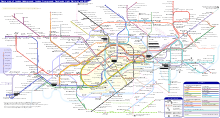
Passenger services operated across London through the Snow Hill Tunnel from mid-Victorian times until World War I, when services terminated at Moorgate from the Midland line to the north, and at Holborn Viaduct from the south, at a time when most inner cross-London traffic had been lost to buses and trams. There were low-level platforms under the main part of Holborn Viaduct station known as the Snow Hill platforms: these can still be seen when leaving City Thameslink station travelling northwards.
On 14 June 1941 railwayman George Dow proposed in an article in the London evening newspaper The Star that new routes be built in tunnels from Marylebone south to Victoria, and from King's Cross south to Charing Cross. Both were to connect with a Paddington–Liverpool Street tunnel that he proposed, anticipating Crossrail by 40 years. He also proposed a north-east/south- west route from Liverpool Street to Charing Cross, all designed to give London a comprehensive main-line network of connections.[16]
The Snow Hill Tunnel route remained open for cross-London freight trains until 1970, when the short section between Farringdon and Holborn Viaduct was closed.
Overhead electrification, completed in 1982, allowed the northern section to run as the Midland City Line from Bedford via the Midland Main Line to St Pancras, and via the City Widened Lines to Moorgate.[17]
The Snow Hill tunnel was re-opened by British Rail to passenger trains after 72 years, with Thameslink beginning in May 1988.[18] On 29 January 1990 the section between Blackfriars and Farringdon was temporarily closed to permit the construction of a new alignment. The route through the site of the long-closed Ludgate Hill station, over Ludgate Hill to Holborn Viaduct was abandoned and demolished. The replacement route under Ludgate Hill was opened on 29 May 1990 by the Network SouthEast (sector of British Rail) concurrently with City Thameslink station, which was initially called St Paul's Thameslink but was renamed in 1991 to avoid confusion with St. Paul's station on the Underground (Central line), about 500 m (550 yd) away.
King's Cross Thameslink on Pentonville Road closed on 8 December 2007 when the Thameslink platforms at nearby St Pancras opened.
In the south the services divide: main-line trains run through London Bridge to East Croydon and Brighton, but the other route has a more convoluted history. In 1988–91 trains went via Bromley to Orpington and Sevenoaks, and via Herne Hill and East Croydon to Purley (off peak only). Later, non-Brighton trains ran via Elephant & Castle and Streatham to West Croydon, Carshalton Beeches, Sutton, Epsom, Leatherhead and Effingham Junction, to Guildford.
On the privatisation of British Rail, Thameslink was franchised to Thameslink, a subsidiary of Govia.
Around 1994 the second branch was cut back to West Croydon as this route crossed the commuter networks of what were to become several different rail companies, and rail privatisation made the route increasingly difficult to maintain.
Around 1995 the route was changed completely, with a route to Sutton via Mitcham Junction continuing on a loop to Wimbledon rejoining itself south of Streatham replacing the West Croydon service.
By late 1998, more than 28,000 passengers were carried at morning peak times.[19]
From 1 April 2006 the franchise was taken over by First Capital Connect along with some services previously operated by WAGN.[20] The branding of most trains, stations, and signs was changed to match the name of the new company, but City Thameslink and West Hampstead Thameslink were not renamed as Thameslink referred to the route.[21] After criticism of the loss of the apt name for this group of routes,[22] First Capital Connect's publicity began calling this set of services its "Thameslink route" to distinguish it from the former WAGN services.
On 14 September 2014, Govia Thameslink Railway took over operations from First Capital Connect.[23]
Thameslink Programme

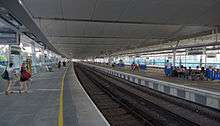
Following the success of the original scheme, plans were drawn up to upgrade the network to cope with the increasing passenger numbers that have led to severe peak-time overcrowding.[24] Network Rail obtained planning permission and legal powers in 2006,[25] funding was secured in July 2007[26] and construction began in October 2007.[27] Plans included rebuilding the station buildings at Farringdon (in conjunction with the Crossrail project) and West Hampstead Thameslink, total rebuild of London Bridge and Blackfriars stations, two new underground platforms at St Pancras International, a new tunnel north of St Pancras International to the East Coast Main Line to allow through services to Peterborough and Cambridge in 2017, and platform lengthening, now being completed. A new 8 and 12 carriage fleet of Class 700 trains began entering service in 2016.
The London and South East Route Utilisation Strategy published in July 2011 lays out a provisional 24tph timetable. South of London it would provide four trains to Brighton (one semi-fast, one stopping) and two each to Three Bridges, Horsham, East Grinstead, Caterham, Tattenham Corner, Tunbridge Wells, Ashford International, Maidstone East, Sevenoaks and Bellingham. North of London there would be eight semi-fast trains to Bedford, four stopping trains to St Albans, two stopping and two semi-fast trains to Luton, two semi-fast trains to Peterborough, two semi-fast trains to Cambridge and four stopping trains to Welwyn Garden City.[28]
Below is a provisional timetable for Thameslink once the upgrade is complete.
| Regional Routes | ||||||||
|---|---|---|---|---|---|---|---|---|
| No. | Northern terminus | Central London | Southern terminus | Length | Times (core) | |||
| 1 | Bedford | semi-fast | via London Bridge | Brighton | fast | 12-car | All day | |
| 2 | ||||||||
| 3 | Bedford | semi-fast | via London Bridge | Gatwick Airport (via Redhill) | semi-fast | 12-car | All day | |
| 4 | ||||||||
| 5 | Peterborough | semi-fast | via London Bridge | Horsham (via Redhill) | semi-fast | 12-car | All day[lower-alpha 1] | |
| 6 | ||||||||
| 7 | Cambridge | semi-fast | via London Bridge | Brighton | fast | 12-car | All day[lower-alpha 1] | |
| 8 | ||||||||
| 9 | Cambridge | stopping | via London Bridge | Maidstone East[lower-alpha 2] | semi-fast | 8-car | All day[lower-alpha 3] | |
| 10 | ||||||||
| 11 | Bedford | fast | via London Bridge | East Grinstead | stopping | 12-car | Peak only | |
| 12 | ||||||||
| 13 | Bedford | fast | via London Bridge | Littlehampton (via Hove) | fast | 12-car | Peak only | |
| 14 | ||||||||
| Commuter Routes | ||||||||
| No. | Northern terminus | Central London | Southern terminus | Length | Times | |||
| 15 | Luton | all stations[lower-alpha 4] | via London Bridge | Rainham (via Greenwich) | all stations[lower-alpha 5] | 8-car | All day | |
| 16 | ||||||||
| 17 | St Albans City | all stations | via Elephant & Castle | Sutton (via Mitcham Junction) | all stations | 8-car | All day | |
| 18 | ||||||||
| 19 | St Albans City | all stations | via Elephant & Castle | Sutton (via Wimbledon) | all stations | 8-car | All day | |
| 20 | ||||||||
| 21 | Luton (peak only) Kentish Town (off-peak) |
all stations | via Elephant & Castle | Orpington (via Catford) | all stations | 8-car | All day[lower-alpha 6] | |
| 22 | ||||||||
| 23 | Welwyn Garden City (peak only) London Blackfriars (off-peak) |
stopping | via Elephant & Castle | Sevenoaks (via Catford and Otford) | all stations | 8-car | All day[lower-alpha 7] | |
| 24 | ||||||||
Rolling stock
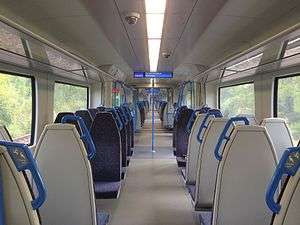
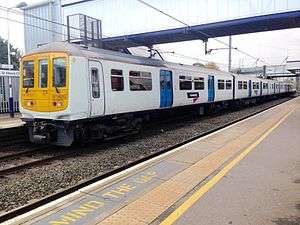
Class 319
Rolling stock used on Thameslink included the 86 Class 319 trains built between 1987–1988 and 1990. These are electrically powered dual-voltage four-car units rated to carry 289, 308 or 319 passengers. Four Class 319 trains had been transferred from Southern in December 2008 and the last four followed in March 2009, from which point they were all on Thameslink. The last was withdrawn in August 2017.[29]
Class 377
First Capital Connect acquired 23 four-coach Class 377 sets during 2009 on sublease from Southern, for the Thameslink route for additional capacity and to allow some of the Class 319 trains to be released for the Catford Loop service to Sevenoaks, now jointly operated with Southeastern under Key Output 0 of the Thameslink Programme.[30]
Class 317
Class 317 units built in the early 1980s were still in use when services into Moorgate ceased in March 2009: the last timetabled service ran from Farringdon to Bedford on 9 October 2009.
Class 700
New energy-efficient Class 700 trains provided an additional 14,500 seats and will be delivered from 2015 to 2018.[31] Siemens Mobility was named preferred bidder on 16 June 2011, with the Desiro City train family.[32] The contract was signed in June 2013[33] for 1140 carriages, with 55 twelve-car and 60 eight-car trains. The depots are at Hornsey and Three Bridges.[32] The Three Bridges depot opened in October 2015 and the first trains entered service in spring 2016.
Class 387
Due to delays in the new Class 700 fleet, the DfT and Southern ordered 116 electric dual-voltage 110-mile-per-hour (180 km/h) carriages (29 trains) with the option for another 140 carriages (35 trains).[34][35] The tender for the new Class 387 trains was won by Bombardier and the first set entered service in December 2014, with all in service by May 2015. These trains will move to Great Northern once the Class 700 is fully delivered.[36]
Electrical power
All rolling stock used on Thameslink is electrically powered dual-voltage units using 25 kV AC overhead power north of Farringdon and 750 V DC third rail to the south.
Fleet
| Class | Image | Type | Top speed | Number | Routes operated | Built | |
|---|---|---|---|---|---|---|---|
| mph | km/h | ||||||
| Class 700 Desiro City | EMU | 100 | 160 | 115 | Whole Thameslink route | 2014–18 | |
2014 franchise
The invitation to tender for the Thameslink, Southern and Great Northern franchise was expected to be issued in October 2012, with the contract commencing in September 2013. On 29 March 2012, the Department for Transport announced Abellio, FirstGroup, Govia, MTR Corporation and Stagecoach Group had pre-qualified to bid for the franchise.[37]
Due to problems with the InterCity West Coast tendering process, the process was delayed, with the new franchise delayed until September 2014. The new franchise includes the South Central franchise currently operated by Southern and certain routes from the Integrated Kent Franchise currently operated by Southeastern.[38]
On 23 May 2014, it was announced that the franchise has been awarded to Govia Thameslink Railway.[39] The new Thameslink Southern & Great Northern franchise[23] will include both the Thameslink Great Northern and South Central franchises.
Govia Thameslink Railway began operations on 14 September 2014, with the former First Capital Connect routes Thameslink and Great Northern.
Thameslink 2
Railfuture, an organisation campaigning for better rail services for passengers and freight, has proposed an additional north-south route, connecting the Brighton Main Line to routes north of London, via East Croydon, Lewisham, Canary Wharf, and Stratford.[40]
See also
- Crossrail – an East-West route through London under construction
- West London Line – the North West-South route across London
- Réseau Express Régional – the similar cross city rail network in Paris
- Cross-City Line – a similar North-South route across Birmingham
- Rail transport in Great Britain
Notes
- Hourly on Sundays.
- Some limited and irregular peak-time extensions to Ashford International.
- On Sundays, service will run hourly between Cambridge and Kings Cross only; it will not run through the core section or on to Maidstone.
- Except for Kentish Town, Cricklewood and Hendon.
- Except for Woolwich Dockyard, Belvedere and Erith.
- No service on Sundays.
- An all-day service will operate between London Blackfriars and Sevenoaks only, with no service through the core outside of peak hours.
References
- "Train times: Thameslink Route" (PDF). First Capital Connect. December 2011. pp. 95, 98. Archived from the original (PDF) on 17 April 2012. Retrieved 1 April 2012.
- Table 25 National Rail timetable, May 2020 (Cambridge - London)
- Table 184 National Rail timetable, May 2020 (London - Brighton)
- Table 196 National Rail timetable, May 2020
- Table 25 National Rail timetable, May 2020
- Table 25 National Rail timetable, May 2020 (Peterborough - London)
- Table 183 National Rail timetable, May 2020 (London - Horsham)
- Table 52-MML National Rail timetable, May 2020 (Bedford - London)
- Table 183 National Rail timetable, May 2020 (London - Gatwick Airport)
- Table 201 National Rail timetable, May 2020
- Table 52-MML National Rail timetable, May 2020 (Luton - London)
- Table 179 National Rail timetable, May 2020
- Table 52-MML National Rail timetable, May 2020 (St Albans - London)
- Table 182 National Rail timetable, May 2020
- Table 188 National Rail timetable, May 2020
- Telling the Passenger Where to Get Off, Andrew Dow, 2009, pages 52–55.
- This service was colloquially known as the Bedpan Line from the contracted names of the terminal stations, as had happened with the Bakerloo line. In general limited-stop trains served St Pancras, and all-stations trains Moorgate.
- "Station Name: Snow Hill/Holborn Viaduct Low Level". Disused Stations News. Subterranea Britannica. 8 December 2007. Retrieved 17 June 2008.
- "Sustained Passenger Growth in London" (Press release). Strategic Rail Authority. 29 March 1999. Retrieved 17 June 2008.
- "Department of Transport announces winner of Thameslink/GN franchise" (Press release). Central Office of Information News Distribution Service. 13 December 2005. Retrieved 17 June 2008.
- King's Cross Thameslink kept the Thameslink suffix until it closed on 8 December 2007.
- "Letter from TfL to FCC".
- "New rail franchising deal set to transform passenger services across London and south east" (Press release). Department for Transport. 23 May 2014. Retrieved 11 June 2015.
- Network Rail. "Thameslink Programme". Retrieved 18 October 2006.
- "The £3.5bn Thameslink Project clears major hurdle" (Press release). Network Rail. 18 October 2006. Archived from the original on 4 March 2007. Retrieved 16 June 2011.
- Coward, Andy (15 August 2007). "Cross-river rail to boost Capital". Rail. Peterborough (572): 40–43.
- "Work begins on Thameslink project". BBC News. 24 October 2007. Retrieved 24 October 2007.
- London and South East Route Utilisation Strategy page 72
- Thameslink replaces last of 30 year old Class 319 fleet Rail Technology Magazine 1 September 2017
- The Class 377 units also operate the peak-hour Bedford to Ashford/Medway towns services as 8-car trains. The first class 377/5 trains started running on 24 March 2009. "Do we really have to wait until 2012 and 2015 for some relief to the overcrowding?". First Capital Connect. 20 October 2008. Archived from the original on 9 November 2008. Retrieved 28 October 2008.
-
"Thameslink gets 14,500 more seats". BBC News. 9 April 2008. Retrieved 1 June 2008.
The deal, announced by Transport Secretary Ruth Kelly, will mean the current 720-carriage Thameslink fleet increasing by 380 carriages. A contract for the new carriages is expected to be awarded in summer 2009, with the first train in service by 2012.
- "Siemens beats Bombardier to Thameslink train order". Railway Gazette International. London. 16 June 2011.
- "Siemens Thameslink deal to create up to 2,000 new jobs". Department for Transport. 27 June 2013.
- "Boost to train builders". Department for Transport. 21 December 2012. Retrieved 23 May 2014.
- Procurement of New Rolling Stock Archived 29 March 2013 at the Wayback Machine – (press release) The potential competition for 116 electric (dual voltage) new rolling stock vehicles, with an option for a further 100 vehicles, would be openly tendered via the rail Link-Up system. The new rolling stock will be of dual voltage configuration and is required to operate up to 110 mph. Any rolling stock manufacturer registered on the rail Link-Up system would be able to compete for this opportunity.
- "Trio of GTR Class 387/1s readied for move to Great Northern duties". PressReader. Retrieved 4 August 2016.
- "UK franchise pre-qualified bidders announced". Railway Gazette International. London. 29 March 2012.
- Thameslink Southern & Great Northern Invitation to Tender. Department for Transport. 26 September 2013.
- "Govia wins Thameslink rail franchise". BBC News. 28 January 2014. Retrieved 23 May 2014.
- "Railfuture – Thameslink 2".
Further reading
External links
| Wikimedia Commons has media related to Thameslink. |
- Official Thameslink Programme website
- Thameslink Programme – Network Rail
- Thameslink 2000 Public Inquiry 2005 – official website for the second public inquiry
- Strategic Rail Authority Strategic Plan, 30 January 2003, page 101 and route descriptions page 27.
- alwaystouchout.com – information and news on the Thameslink Programme
- Brent Cross Thameslink station – Planning application for new Thameslink station at Brent Cross.



